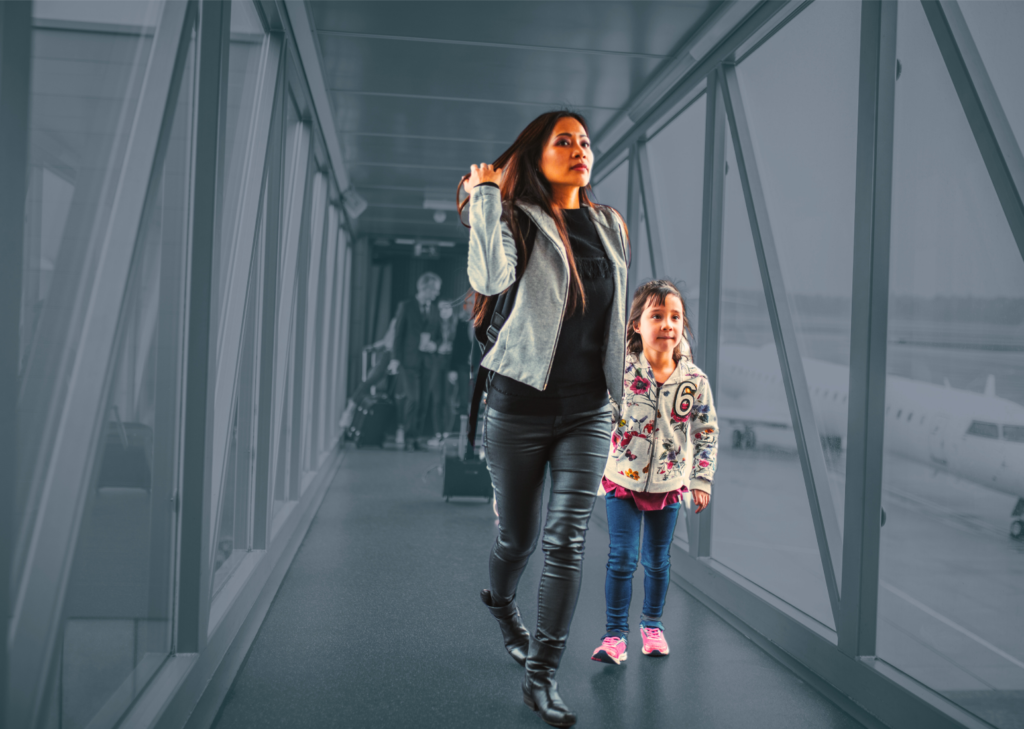Human trafficking is becoming more and more of a buzzword these days. And it’s easy to mistake certain situations as being suspicious of human trafficking, when they really are indicative of something else, not human trafficking.
Remember, the three most important aspects of what constitutes human trafficking as a crime are that either force, fraud or coercion are involved.
Let’s go over seven common situations that might look like human trafficking on the surface, but really aren’t.
1. Adults Traveling with Minors
Seeing an adult traveling with a child who doesn’t appear to be biologically related can be bothersome. And there have been real-life scenarios where a parent has been detained under suspicion of trafficking the child they are accompanying, but have turned out to be falsely accused.
It’s important to remember that families come in all shapes and sizes. Intercultural marriages are becoming more and more common and so their offspring may not identically resemble their parents. Additionally, grandparents, foster parents, and other legal guardians often travel with children as well.
A child traveling with an adult who doesn’t look related to them doesn’t necessarily suggest something nefarious is going on. But there are other clues to look out for that may raise your suspicion that something is going on.

It’s best to remember to take as much of the situation into account that you are aware of before jumping to conclusions. If more than a few things add up, it may be best to report your suspicions to the authorities.
Some possible indicators could be:
- The child looks distressed or fearful.
- The child shows minimal interaction with the adult they’re with, e.g. not looking them in they eye or looks frightened or withdrawn.
- The child is wearing clothes inappropriate for the weather.
- The accompanying adult doesn’t have any type of activities or snacks for the child or the child isn’t carrying a backpack of their own with things to keep them occupied.
2. Migrant Workers
It’s easy to jump to conclusions about this population and automatically label them as victims of labor trafficking, but think again. There are many legal migrant work programs that allow foreign nationals to work in our country with proper documentation.
However, traffickers will go to great lengths to exploit this system and, in turn, exploit those they recruit. The worker may be here on legal terms, but their legal documents, including their passport and visa may be confiscated by the trafficker. The trafficker may deliberately keep them here past their legalized obligation threatening deportation to force them to continue to work.
3. Recruiting Agencies
There are many legitimate job agencies that involve interviews, background checks and even travel arrangements for qualified candidates. Companies may even sponsor visas for specific skilled workers from abroad – all of this being completely legal.
However, there are bad actors who will cheat the system and create fake agencies with legit looking websites, office locations, employees, interviews, etc. Once the candidate is “hired,” the real exploitation begins. Documents might be forged, travel arrangements becomes debt bondage, and the promised job turns into a nightmare.
4. Poor Working Conditions
Unfortunately, unfair labor practices and poor working conditions are widespread all across the world. Workers might face low unlivable wages, long hours, or unsafe environments.
While definitely concerning, this is labor exploitation, not trafficking.
Labor trafficking goes beyond unfair working conditions; it involves forced labor with limited freedom and a complete lack of control over one’s life. If force, fraud, or coercion are involved, it becomes a crime of human trafficking.
5. Runaway Teens
A missing teen is a serious concern and should be reported to authorities immediately.
However, not every runaway is a trafficking victim. Teens may run away due to something happening in the home – a family conflict, bullying or simply seeking independence.
A teen who does find themselves on the street is now in survival mode and may be approached by a trafficker offering them food, a safe place to sleep or something else of value. If this is the case and the runaway accepts their offer, the trafficker will now use that situation to their advantage and exploit them saying, “I did this for you. Now, you owe me,” beginning the never-ending cycle of exploitation.
6. Prostitution for Adults
While sex trafficking and prostitution may be conflated as one and the same, it’s not. There are consenting adults who choose to prostitute themselves as their occupation.
While the legality and morality of this type of “work” is complex with strong opinions on both sides, it’s crucial to understand that coercion is a key factor in sex trafficking. If someone is forced to prostitute themselves through violence, threats or debt bondage, or were tricked into it, it becomes trafficking. Remember, that a child under the age of 18 cannot consent to perform a commercial sex act and are automatically considered a commercially sexually exploited child (CSEC).
7. Smuggling
We’ve all seen it. Those news reports on the18-wheeler trailers full of immigrants being abandoned or somehow caught, with sadly many losing their lives in the process. They call it human trafficking. But it’s actually smuggling.

While this is a crime, it is distinct from human trafficking.
Smuggling involves the illegal transportation of people who consent to the act, typically entering a country they cannot enter legally. Smugglers might charge exorbitant fees and put people at risk during transport, but the migrants are not subjected to forced labor or exploitation.
However, it’s important to note that a smuggling situation can turn into human trafficking. Smugglers might abandon them, leaving them vulnerable to traffickers. Alternatively, migrants might become indebted to the smugglers, creating a forced labor situation.
Again, it’s imperative that you not jump to conclusions right away. Human trafficking is a complex crime.
Checking off all the indicators on a list doesn’t automatically make that person a victim of human trafficking. The best advice is to listen to your gut. If something feels wrong, report it.
How To Report:
- Call 9-1-1, if someone is in imminent danger.
- National Human Trafficking Hotline: 1-888-373-7888
- National Center for Missing and Exploited Children (NCMEC): 1-800-843-5678 (1-800-THE-LOST)

